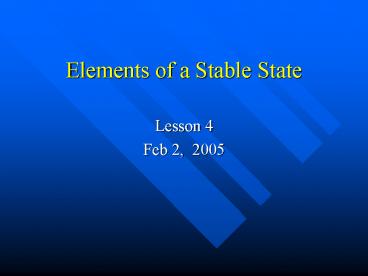Elements of a Stable State - PowerPoint PPT Presentation
1 / 41
Title:
Elements of a Stable State
Description:
Strength. Minimal Functions. Providing pure public goods. Defense, law, and order. Property rights ... Strength. Intermediate Functions. Addressing ... – PowerPoint PPT presentation
Number of Views:548
Avg rating:3.0/5.0
Title: Elements of a Stable State
1
Elements of a Stable State
- Lesson 4
- Feb 2, 2005
2
What makes a stable state?
- Security
3
What makes a stable state?
- Security
- Good Governance
4
What makes a stable state?
- Security
- Good Governance
- Rule of Law
5
What makes a stable state?
- Security
- Good Governance
- Rule of Law
- Economic and Social Well-being
6
Questions that drive intervention
- What are the problems posed?
7
Questions that drive intervention
- What are the problems posed?
- Is outside help necessary?
8
Questions that drive intervention
- What are the problems posed?
- Is outside help necessary?
- How can disputes be resolved peaceably?
9
Questions that drive intervention
- What are the problems posed?
- Is outside help necessary?
- How can disputes be resolved peaceably?
- Which strategies work best?
10
Questions that drive intervention
- What are the problems posed?
- Is outside help necessary?
- How can disputes be resolved peaceably?
- Which strategies work best?
- How can these strategies be implement?
11
Face Many Challenges
- Disarmament
- Demobilization
- Reintegration
- Resettlement
- Reforms
12
Stabilization and Reconstruction
- Relief
- Rehabilitation Restore
- Reconstruction Development
13
Transforming
14
Transforming
- Dictator
- Autocratic
- Totalitarian State
15
Transforming
Anocratic
- Dictator
- Autocratic
- Totalitarian State
Limited Democracy
- Grievances
- Greed
16
Transforming
Anocratic
- Dictator
- Autocratic
- Totalitarian State
Limited Democracy
- Market Economy
- Rule of Law
- Legitimate Government
- Civil Liberties
- Grievances
- Greed
Limited Capacity and Institutions
17
Transforming
Anocratic
- Dictator
- Autocratic
- Totalitarian State
Limited Democracy
- Market Economy
- Rule of Law
- Legitimate Government
- Civil Liberties
- Liberal Democracy
- Grievances
- Greed
Limited Capacity
18
What is Nation Building?
- Creation of an integrating ideology
- Creation of an integrated society
- Creation of a functioning state apparatus
19
Nation Building ?
- How to promote governance
20
Nation Building ?
- How to promote governance
- Improve their democratic legitimacy
21
Nation Building ?
- How to promote governance
- Improve their democratic legitimacy
- Strengthen self-sustaining institutions
22
Marshall Plan-TypeSolutions
- Incompatible with multidimensional nature
- of current reconstruction
- Tend to overemphasize the economic factor in a
wide range of - structural problems
- Tend to forget time and past history
23
Types of Nation Building
- Post-conflict reconstruction
- Modicum of stability after collapse
- Strengthening weak states before collapse
24
State Services
Strength
- Minimal Functions
- Providing pure public goods
- Defense, law, and order
- Property rights
- Macroeconomic management
- Public health
- Improving equity
- Protecting the poor
Scope
World Bank 2003
25
State Services
Strength
- Intermediate Functions
- Addressing externalities
- Education,
- Environment
- Financial regulations
- Regulating monopoly
Scope
World Bank 2003
26
State Services
Strength
- Activist Functions
- Industrial policy
- Wealth redistribution
Scope
World Bank 2003
27
State Services
Strength
- Minimal Functions
- Providing pure public goods
- Defense, law, and order
- Property rights
- Macroeconomic management
- Public health
- Improving equity
- Protecting the poor
- Intermediate Functions
- Addressing externalities
- Education,
- Environment
- Financial regulations
- Regulating monopoly
- Activist Functions
- Industrial policy
- Wealth redistribution
Scope
World Bank 2003
28
Missing Dimensions of Stateness
Strength
Scope
29
States and Services
Strength
Strong institutions and an extensive state
Limited state functions with strong
institutional effectiveness
Ineffective state takes on an ambitious range
of activities that it cannot perform
Weak institutions and a limited state
Scope
30
States and Services
France
I
II
Japan
United States
Germany
Russia
England
Strength of state
Turkey
III
IV
Brazil
Sierra Leone
Scope of state functions
31
Development is political
- Markets and their operation (e.g. debates about
privatization) - Economic production (industry, mining and
agriculture) - Education (how much, for whom, and at what cost)
- Infrastructure (especially roads and big dams)
- Provision of "basic needs"
- Protection and/or promotion of human rights
- Security and defense
32
Multiple Actors
- The International Monetary Fund
- The World Bank
- National governments
- Political parties or social movements
- Non-governmental organizations
- Communities
- Social groups and classes (e.g. women, the poor,
labor)
33
Struggles Occurs
- Trade liberalization
- Privatization of state-owned industries and
utilities - The destruction of rainforests and other
ecosystems - Infrastructure projects
- Currency devaluation
34
Security Sector
- Political security and governance
- Community security and societal stability
- Personal security and human rights
- Economic security
35
Good Governance
- Based on the Rule of Law
- Separation of powers
- Officials elected by the people
- Civilian control of the government
36
Rule of Law
- Legal Justice
- Rectificatory Justice
- Distributive Justice
37
State-building Lessons
- Holistic approach
- Single leader with authority
- Solve root cause
- Security rule of law
- Disarm, demobilize, reintegrate
- Structure of the state
- Political and economic reforms
38
Agenda for success
- Focus on root causes
- Attend to context specificity
- Must be sustainable
- Mobilization of resources
- Holistic approach
39
Initial tasks
- Revive restore social service
- Assist displaced people
- Resettlement
- Property right
- Gainful employment
40
Two conflicting approaches
- Conflict Managers
- Democratizers
41
(No Transcript)






























